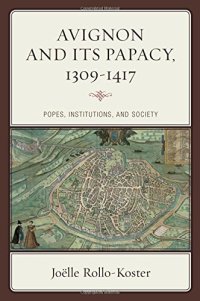
Ebook: Avignon and Its Papacy, 1309-1417: Popes, Institutions, and Society
Author: Joëlle Rollo-Koster
- Tags: Popes the Vatican Catholicism Leadership Christian Living France Europe History Christianity Religious World General Reference Almanacs Yearbooks Atlases Maps Careers Catalogs Directories Consumer Guides Dictionaries Thesauruses Encyclopedias Subject English as a Second Language Etiquette Foreign Study Genealogy Quotations Survival Emergency Preparedness Test Preparation Words Grammar Writing Research Publishing Studies Religion Spirituality Humanities New Used Rental Textbooks Specialty Boutiqu
- Year: 2015
- Publisher: Rowman & Littlefield Publishers
- Language: English
- pdf
With the arrival of Clement V in 1309, seven popes ruled the Western Church from Avignon until 1378. Joëlle Rollo-Koster traces the compelling story of the transplanted papacy in Avignon, the city the popes transformed into their capital. Through an engaging blend of political and social history, she argues that we should think more positively about the Avignon papacy, with its effective governance, intellectual creativity, and dynamism. It is a remarkable tale of an institution growing and defending its prerogatives, of people both high and low who produced and served its needs, and of the city they built together.
As the author reconsiders the Avignon papacy (1309–1378) and the Great Western Schism (1378–1417) within the social setting of late medieval Avignon, she also recovers the city’s urban texture, the stamp of its streets, the noise of its crowds and celebrations, and its people’s joys and pains. Each chapter focuses on the popes, their rules, the crises they faced, and their administration but also on the history of the city, considering the recent historiography to link the life of the administration with that of the city and its people. The story of Avignon and its inhabitants is crucial for our understanding of the institutional history of the papacy in the later Middle Ages. The author argues that the Avignon papacy and the Schism encouraged fundamental institutional changes in the governance of early modern Europe—effective centralization linked to fiscal policy, efficient bureaucratic governance, court society (société de cour), and conciliarism. This fascinating history of a misunderstood era will bring to life what it was like to live in the fourteenth-century capital of Christianity.
As the author reconsiders the Avignon papacy (1309–1378) and the Great Western Schism (1378–1417) within the social setting of late medieval Avignon, she also recovers the city’s urban texture, the stamp of its streets, the noise of its crowds and celebrations, and its people’s joys and pains. Each chapter focuses on the popes, their rules, the crises they faced, and their administration but also on the history of the city, considering the recent historiography to link the life of the administration with that of the city and its people. The story of Avignon and its inhabitants is crucial for our understanding of the institutional history of the papacy in the later Middle Ages. The author argues that the Avignon papacy and the Schism encouraged fundamental institutional changes in the governance of early modern Europe—effective centralization linked to fiscal policy, efficient bureaucratic governance, court society (société de cour), and conciliarism. This fascinating history of a misunderstood era will bring to life what it was like to live in the fourteenth-century capital of Christianity.
Download the book Avignon and Its Papacy, 1309-1417: Popes, Institutions, and Society for free or read online
Continue reading on any device:

Last viewed books
Related books
{related-news}
Comments (0)